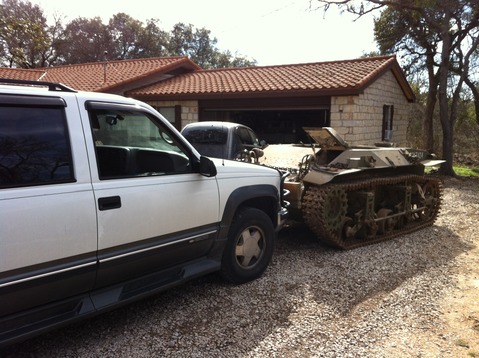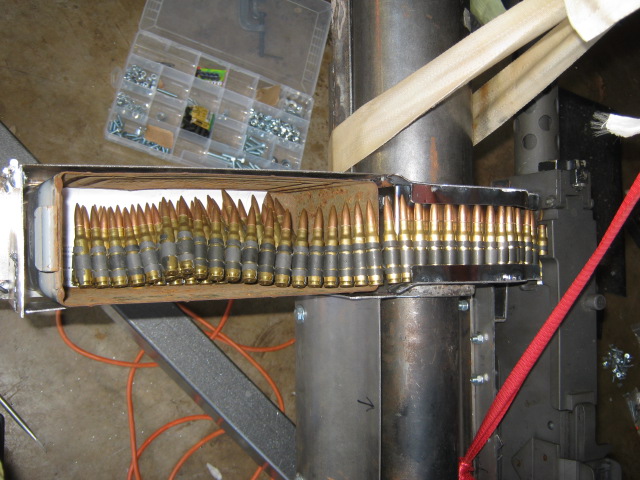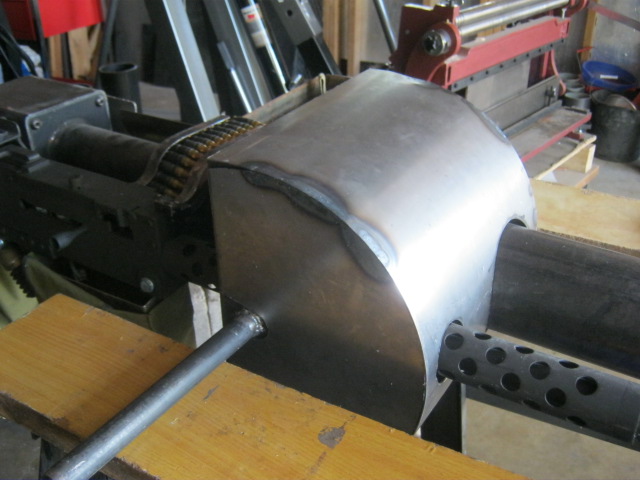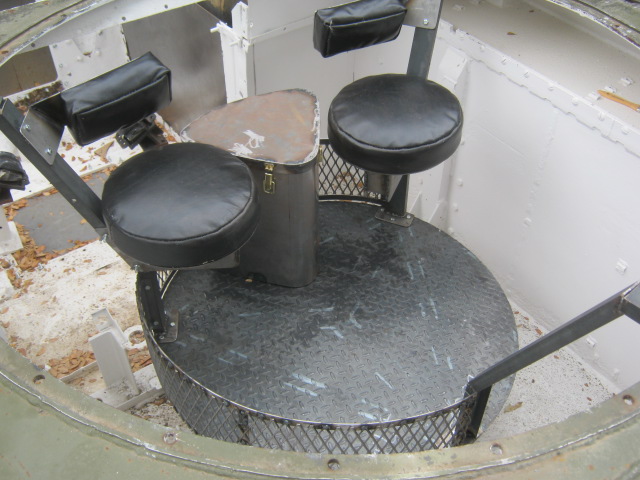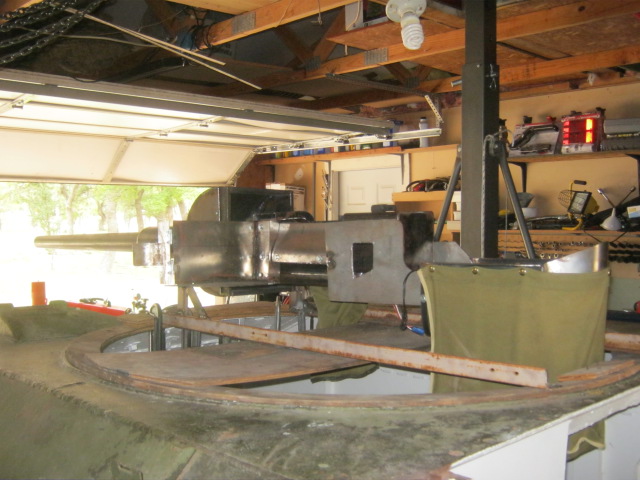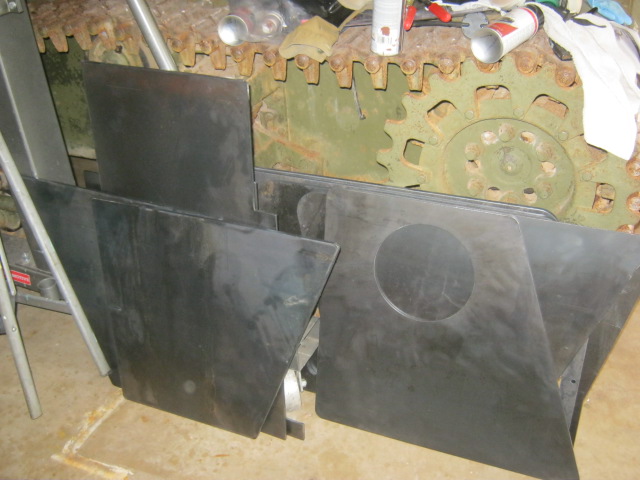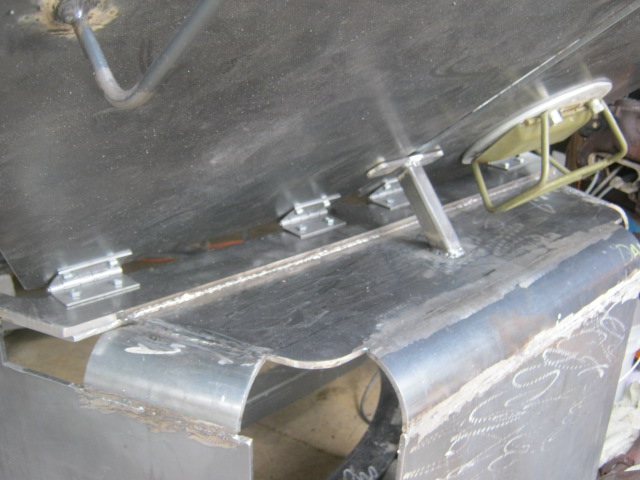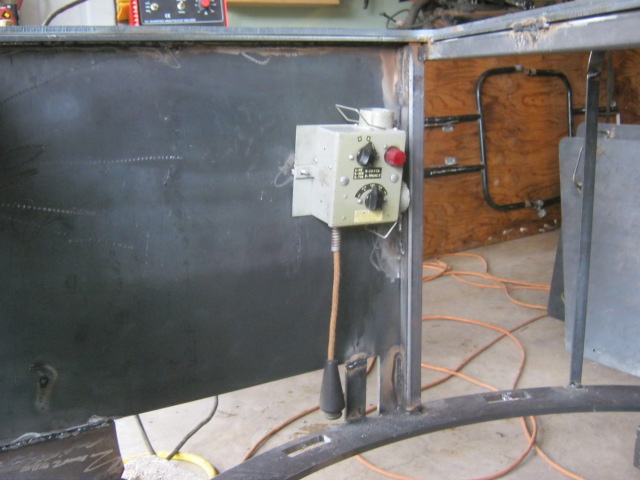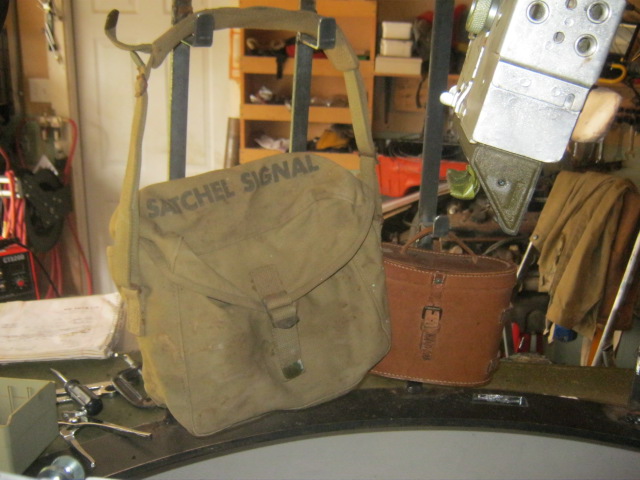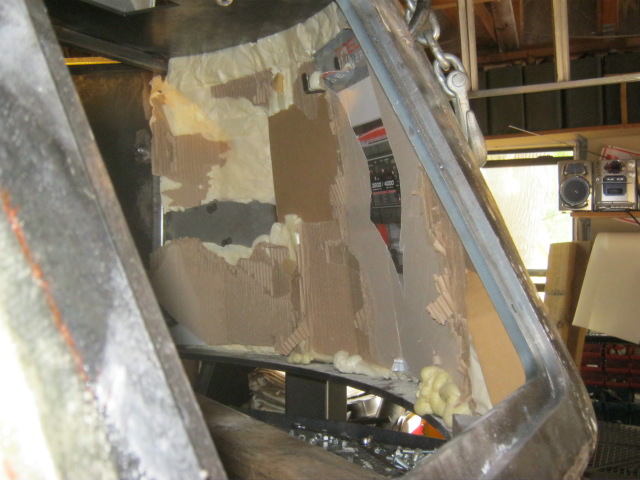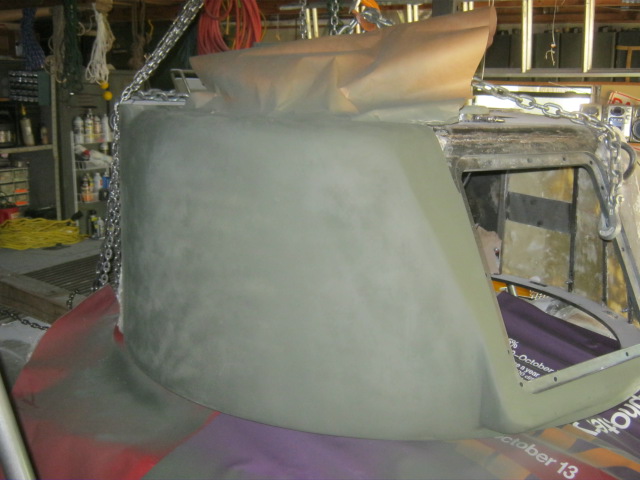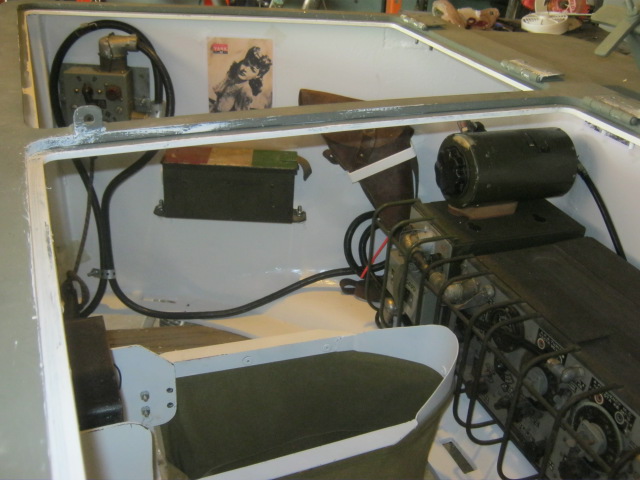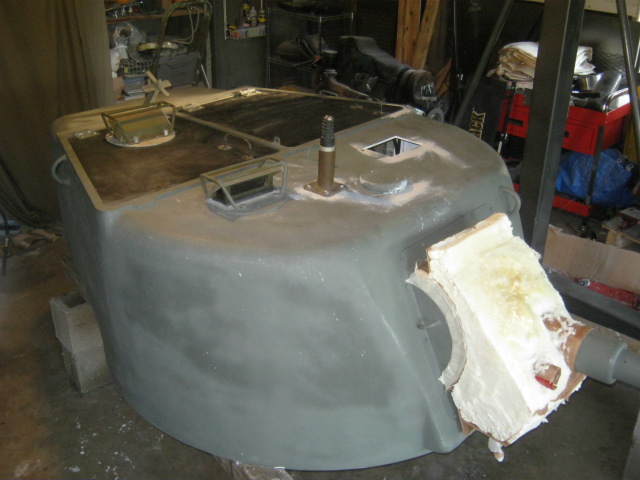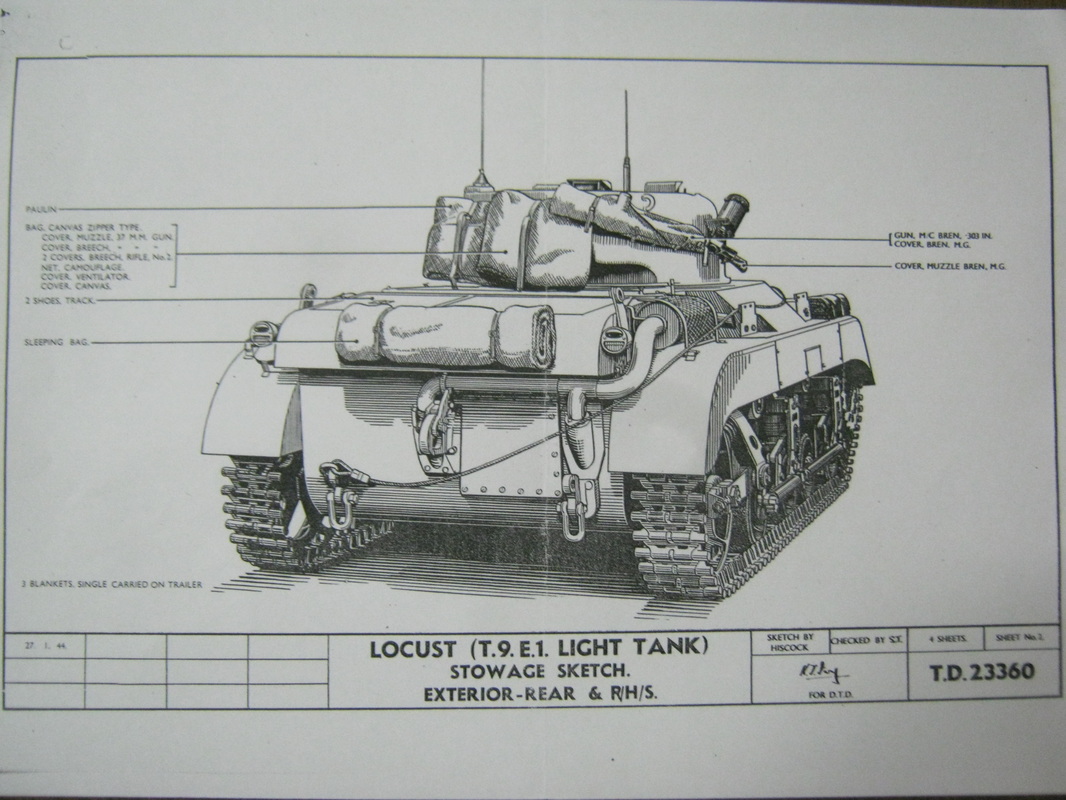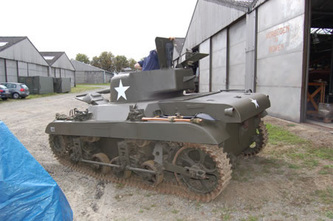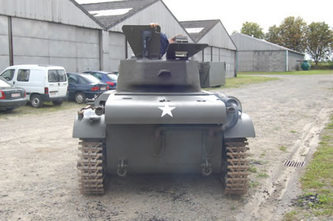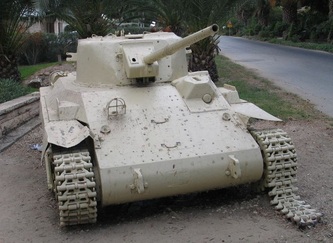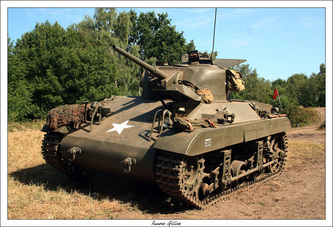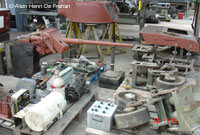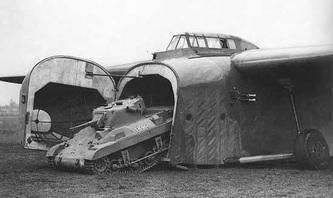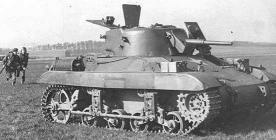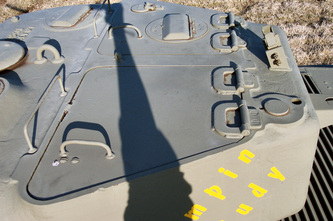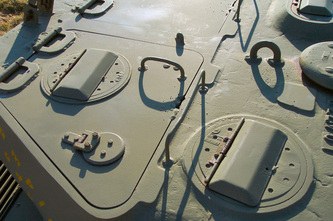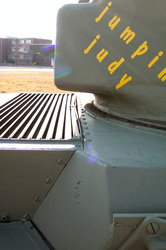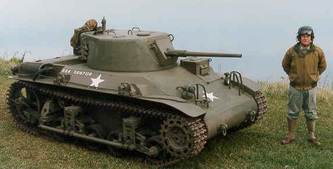M-22 Locust Airborne Light Tank
Early in the formation of Britain's airborne forces, after the disaster of the Battle of France in 1940, discussions about the concept of what shape the future airborne forces should take were governed by lessons learned from the defeat on the continent. It was noted that the german airborne forces played a vital role ahead of the german armored spearheads, and that traditional infantry, without the assistance of tanks and armored vehicles, and the capability to defeat enemy armored vehicles, were helpless in the new age.
From lessons learned from the german airborne operations, it was determined that any future british airborne force should be equipped not just with light anti-tank weapons and mortars for support as the germans had done, but should be equipped with tanks and armored carriers and light artillery, to fight as a combined arms team, and that heavy cargo gliders capable of delivering those weapons were needed.
The only suitable tank in the British inventory at the time was the Tetrarch light tank, so a requirement was ordered for a glider capable of delivering the Tetrarch and other suitable vehicles and heavy weapons into landing zones behind enemy lines. The result was the Hamilcar glider. Further investigations into the use of airborne light tanks and negotiations with the Americans led to a request that the Americans develop a suitable light tank to supercede the Tetrarch, as it could not be produced in the quantities that were foreseen to be eventually needed by Britain's airborne forces. In the early stages of development, it was proposed that ultimately hundreds of tanks would be flown into landing zones behind german lines. This was not to be, but at the time, the requirement was established, and development of the new tank went forward in the United States.
The result was the T9E1 Airborne Light Tank, developed and built by Marmon Herrington Corporation. It's official designation upon acceptance by the U.S. Army became the M-22 Light Tank, and upon its arrival to the British airborne forces, it was named "Locust", a voracious flying insect that devastates everything below, but as others pointed out, also an inoffensive bean from Africa.
The M-22 Locust entered British airborne service in early 1944. It was intended to replace the Tetrarch upon its successful completion of service trials, and its combat debut was planned to be during the invasion of Normandy. But trials revealed mechanical problems, and the 37mm high explosive round of the M6 gun were found to be weak in comparison to the 40mm high explosive round of the 2 Pounder gun in the Tetrarch. So the Tetrarchs stayed in service for the Normandy campaign.
After the Normandy campaign, in the Fall of 1944, the Tetrarch was retired, and completely replaced by the Locust, as the stocks of Tetrarchs could no longer support operational needs.
The combat debut of the Locust in airborne operations came with "Operation Varsity", the airborne element of the battle to cross the Rhine River in Germany. The mission of the Locusts for the operation was to fend off enemy counter-attacks, and act as the 6th Airborne Division reserve, to reinforce the infantry where needed on order. Eight Locusts were air-landed by Hamilcar gliders for the operation on 24 March 1945. One of the tanks fell from a disintegrating glider in flight, and crash landings due to enemy anti-aircraft fire as well as collisions with features on landing such as farm buildings and drainage ditches caused damage and loss to some of the tanks. Of the seven remaining tanks, one was a total write-off as its carrying glider crashed into a famr, and the tank was propelled through the farm buildings, ending up upside down in the rubble. Of the six remaining tanks, only two of them were fully functional with uninjured crews, operational cannons and machineguns and functioning radios, as one of the tanks had a 37mm gun damaged and another had a machinegun damaged. Those six tank crews gave a good account of themselves in the ensuing battle. One was lost in a duel with a german Panther tank minutes after it rolled out of its glider, being knocked out after it had fired half a dozen rounds from its 37mm gun into the Panther. Another became mechanically disabled, but fought it out in place throughout the day and most of the following night supporting british infantry, responsible for an estimate of over 100 german casualties. The other four participated in an attack on german infantry and artillery positions across a rail line, and into the wooded hills overlooking the 6th Airborne Division's Headquarters that had been established in a farm in the landing zone.
On the second day of the airborne operations, the situation had stabilized, and counterattacks from the germans died out. The locusts remained in their defensive positions on the perimeter that had been established upon pulling back from their attacks the day before. On the 26th, the remainder of the division that had not been dropped in on the 24th had completed crossing the Rhine River, and the Locust tanks were swapped out for the regiment's Cromwell tanks that were its assigned tanks used after air operations transitioned to ground operations for further fighting.
That, in a nutshell, is the history of combat usage of the M22 Locust by the 6th Airborne Armored Reconnaissance Regiment in WW2.
From lessons learned from the german airborne operations, it was determined that any future british airborne force should be equipped not just with light anti-tank weapons and mortars for support as the germans had done, but should be equipped with tanks and armored carriers and light artillery, to fight as a combined arms team, and that heavy cargo gliders capable of delivering those weapons were needed.
The only suitable tank in the British inventory at the time was the Tetrarch light tank, so a requirement was ordered for a glider capable of delivering the Tetrarch and other suitable vehicles and heavy weapons into landing zones behind enemy lines. The result was the Hamilcar glider. Further investigations into the use of airborne light tanks and negotiations with the Americans led to a request that the Americans develop a suitable light tank to supercede the Tetrarch, as it could not be produced in the quantities that were foreseen to be eventually needed by Britain's airborne forces. In the early stages of development, it was proposed that ultimately hundreds of tanks would be flown into landing zones behind german lines. This was not to be, but at the time, the requirement was established, and development of the new tank went forward in the United States.
The result was the T9E1 Airborne Light Tank, developed and built by Marmon Herrington Corporation. It's official designation upon acceptance by the U.S. Army became the M-22 Light Tank, and upon its arrival to the British airborne forces, it was named "Locust", a voracious flying insect that devastates everything below, but as others pointed out, also an inoffensive bean from Africa.
The M-22 Locust entered British airborne service in early 1944. It was intended to replace the Tetrarch upon its successful completion of service trials, and its combat debut was planned to be during the invasion of Normandy. But trials revealed mechanical problems, and the 37mm high explosive round of the M6 gun were found to be weak in comparison to the 40mm high explosive round of the 2 Pounder gun in the Tetrarch. So the Tetrarchs stayed in service for the Normandy campaign.
After the Normandy campaign, in the Fall of 1944, the Tetrarch was retired, and completely replaced by the Locust, as the stocks of Tetrarchs could no longer support operational needs.
The combat debut of the Locust in airborne operations came with "Operation Varsity", the airborne element of the battle to cross the Rhine River in Germany. The mission of the Locusts for the operation was to fend off enemy counter-attacks, and act as the 6th Airborne Division reserve, to reinforce the infantry where needed on order. Eight Locusts were air-landed by Hamilcar gliders for the operation on 24 March 1945. One of the tanks fell from a disintegrating glider in flight, and crash landings due to enemy anti-aircraft fire as well as collisions with features on landing such as farm buildings and drainage ditches caused damage and loss to some of the tanks. Of the seven remaining tanks, one was a total write-off as its carrying glider crashed into a famr, and the tank was propelled through the farm buildings, ending up upside down in the rubble. Of the six remaining tanks, only two of them were fully functional with uninjured crews, operational cannons and machineguns and functioning radios, as one of the tanks had a 37mm gun damaged and another had a machinegun damaged. Those six tank crews gave a good account of themselves in the ensuing battle. One was lost in a duel with a german Panther tank minutes after it rolled out of its glider, being knocked out after it had fired half a dozen rounds from its 37mm gun into the Panther. Another became mechanically disabled, but fought it out in place throughout the day and most of the following night supporting british infantry, responsible for an estimate of over 100 german casualties. The other four participated in an attack on german infantry and artillery positions across a rail line, and into the wooded hills overlooking the 6th Airborne Division's Headquarters that had been established in a farm in the landing zone.
On the second day of the airborne operations, the situation had stabilized, and counterattacks from the germans died out. The locusts remained in their defensive positions on the perimeter that had been established upon pulling back from their attacks the day before. On the 26th, the remainder of the division that had not been dropped in on the 24th had completed crossing the Rhine River, and the Locust tanks were swapped out for the regiment's Cromwell tanks that were its assigned tanks used after air operations transitioned to ground operations for further fighting.
That, in a nutshell, is the history of combat usage of the M22 Locust by the 6th Airborne Armored Reconnaissance Regiment in WW2.
The above photos are two of the few surviving photographs of the M22 Locust in combat. The photo to the left is the tank of Lieutenant Kenward of the 6th AARR. It was taken moments after his crew had left their glider upon landing. The nose of the glider failed to open automatically as it should have as the tank rolled forward, so Lt. Kenward ordered his driver to drive straight through the nose of the glider. The damaged skirt over the rear portion of the track may have been due to driving through the nose of the glider. The photo to the right is of Lt. Kenward's tank after his crew's duel with the german Panther tank. Identification of the tank can be confirmed by the damaged skirt visible in the previous photo.
The violence of the impact of the german tank gun fire can be witnessed from the condition of the tank. The gun pointing over the driver's hatch toward the left front of the tank indicates the direction of the Panther that Lt. Kenward's gunner was engaging. The imact of the german round(s) cannot be seen, but presumably entered the gunners side (left, or far side as seen in this photo) of the turret, tearing off the gunner's hatch which is seen in the photo laying on the front slope of the hull. The round presumably passed right through the tank, and the evidence of the broken track on the right side of the hull indicates the round exited the right rear side of the tank, tearing the track apart as it left, with the tank shedding the track as it coasted forward to a stop.
The black and white photo cannot show the color of the tank, but the blackened mangle on the near side of the turret behind the smoke grenade launcher is the remains of the Bren gun that was strapped to the outside of the turret for use in defense against enemy aircraft. Also, it can be determined that the tank has burned completely, as the painted unit and recognition markings on the front of the hull and turret sides have been completely burned off.
Remarkably, Lt. Kenward and at least one of his two other crewmembers survived, being evacuating across the Rhine that night.
The violence of the impact of the german tank gun fire can be witnessed from the condition of the tank. The gun pointing over the driver's hatch toward the left front of the tank indicates the direction of the Panther that Lt. Kenward's gunner was engaging. The imact of the german round(s) cannot be seen, but presumably entered the gunners side (left, or far side as seen in this photo) of the turret, tearing off the gunner's hatch which is seen in the photo laying on the front slope of the hull. The round presumably passed right through the tank, and the evidence of the broken track on the right side of the hull indicates the round exited the right rear side of the tank, tearing the track apart as it left, with the tank shedding the track as it coasted forward to a stop.
The black and white photo cannot show the color of the tank, but the blackened mangle on the near side of the turret behind the smoke grenade launcher is the remains of the Bren gun that was strapped to the outside of the turret for use in defense against enemy aircraft. Also, it can be determined that the tank has burned completely, as the painted unit and recognition markings on the front of the hull and turret sides have been completely burned off.
Remarkably, Lt. Kenward and at least one of his two other crewmembers survived, being evacuating across the Rhine that night.
M22 Locust restoration
The restoration of this Locust started with the previous owner. The turret was removed at the end of the war, and turrets are not available. So any Locust without a turret will remain that way unless a replica is manufactured. The original Lycoming engine was not running, and the previous owner put a 300 Chevy engine and transmission in it. He made a turret from plywood with a PVC gun, plastic garbage can lid covered in canvas for a gunshield, and a propane machinegun simulator as a coaxially mounted machinegun (coax for short). That is the state the tank was in when I purchased it, which is pictured below left on the date of purchase.
Below right is a photo of my first outing with the tank at an airshow in southern Indiana, in column with several other tanks, half tracks and other WW 2 military vehicles moving into our positions for a battle reenactment for the public.
Below right is a photo of my first outing with the tank at an airshow in southern Indiana, in column with several other tanks, half tracks and other WW 2 military vehicles moving into our positions for a battle reenactment for the public.
|
Soon after purchase, the plywood turret was removed and discarded. Trouble arose with the 300 Chevy engine. Unfortunately, the previous owner had discarded the original engine, as it had a cracked block, so he discarded it. I decided to replace the 300 Chevy with a stronger 350 Chevy 4 bolt truck engine, and a 2 speed Powerglide transmission. The photos to left and right were taken at the Fort Knox Auto Craft Shop at Fort Knox, Kentucky, when my friend Don and I swapped out the engine and transmission.
|
|
After a decade (plus) of storage, the Locust is moved next to the garage for further work. Clockwise from left: In the quonset hut where it has been sadly neglected for so long; towing the Locust back from oblivion with the 5 Ton; Locust in front of the house with a beam chained on, ready for pushing; Pushing the Locust back next to the garage with the Suburban; The Locust after a bath and a shop vac-ing, in it's portable garage, ready to have the carburetor cleaned and fluids changed before cranking the engine.
|
|
Top left - Into the garage to remove all the exterior fittings, initial cleaning, and preparation to pull the engine deck and pack. Top center and top right - 'before' photos of front and rear interior of the hull. What a mess! Left - engine and transmission out of the hull, and undergoing to process of de-rusting, treating the bare steel, priming and painting of the interior. Right - Nice and clean, pretty and white! Looking into the tank from the (removed) driver's hatch toward the engine compartment. Lower left - Front interior done working toward the middle of the hull. Below center - what ever Locust tank aspires to!
|
|
Upper right - cutting out plywood templates and fitting them to ensure patterns are right before cutting them in steel. Left - getting an idea of what this will look like when it's a tank again. Right - visions of grandeur from the commander's hatch. Lower left - beginning of the tank armament construction. The armament is built around the forward torch-cut portion of a WW2 37mm gun barrel. The coax M1919 propane 'gas gun' is laid out beside the 37mm and measurements taken. Below center - the 37mm gun is also propane fired, and the 'plumbing' for that are inside the box 'breech' at the rear of the gun.
|
|
Above right - brackets are fitted for the coax, cannon operating plate, gunner's shoulder guard, 'recoil buffer', coax electric firing solenoid, etc. The fittings for propane and oxygen hose hook-ups for the weapons can also be seen covered with blue tape. Left - the completed main armament assembly. The assembly includes the main gun, coax machinegun, recoil assembly, gun sleigh, gunner and commander's guards, operating plate, and spent brass chute for the coax spent brass bag, and spent brass bracket and deflector plate for the main gun 37mm spent casings on the rear of the gun behind the breach. The next step will be manufacturing the gun trunnions and elevation assembly. Right top - the coax feed chute feeds (dummy) belted ammunition into the coax feed chute from the coax ready box, mounted on the left of the gun. Right bottom - the door and retaining bracket for the coax ready box. The door opens and latches as the real one should. The coax machinegun feed tray cover also opens and closes so the gunner can "load" the coax for a feel of more realism.
|
|
Left - operating the coax ready box door and retainer. Right - Coax dummy ammunition belt in the coax ready box.
Below left - trunnion box, trunnions and rotor done. Below center and right - Main gun and coax machinegun spent brass bags done and installed. The main gun brass bag has dummy 37mm shells filled with scrap metal to counterbalance the main gun, and the coax spent brass bag hides the hose and electrical hookups for the 1919 gas gun simulator for machinegun fire. |
|
Left - new belly and back access plates installed into the engine compartment, bulkhead for the fuel tank installed, and fuel tank test-fitted before modifying the mounting brackets and cleaning up and painting the fuel tank.
Right - Turret basket in progress. Turret floor with reinforcement, struts and screens installed, and adjustable tank commander and gunner seat bottoms. Next will come 37mm ammo stowage, turret slip ring, cable channel, seat backs and seat cushions. |
|
Above left - weapon system in place on temporary bracing to take final measurements. Above center - wooden templates in place for final measurements. Above right, this row left and right - precision cut steel plates made from the wooden template patterns. Below left - turret basket complete and painted, minus the slip ring, cable conduit and junction box that will come later. Below center and right - steel plates for the turret shell welded together and details being added such as periscope turntables, hatch handles, etc.
|
|
Upper left - reinforcing ribs welded into the front quarters of the turret shell. Center - back plate in the bustle welded in. Upper right - gun rotor assembly finished, trunnions cut to length, and trunnion bearings in place. Left - trunnion mounts assembled and welded in, and the gun rotor in place. Right - finishing up welding seams on the under surfaces of the turret. Lower left - hatches in place and TC rear periscope mount and turntable in place. Lower center - hatch stop and locking bracket in place. Lower right - Wireless Set 19 mounting bolts welded in and wirless tray in place.
|
|
Left - Wireless control box mounting bolts welded in and control boxes in place. Right - all the initial welding done, the turret is lifted into place. Creative use of leverage and the gantry crane and cherry picker had it in place in about 30 minutes with no pinched fingers or ruptured balls. Lower left - turret heading up over the front slope. Lower center - finishing lowering the turret into place. Lower right - gun assembly reassembled after blasting, priming and painting, mounted in mounting plate, and ready to be lifted into place.
|
|
Left - Gun assembly ready to be lifted into place. Visible are the gun, gun sleigh, gun mount, rotor, trunnion plate, breech, coax mounted .30 cal, .30 cal ammo can and ammo can mounting bracket with feed chute, and dummy ammo belt inserted in coax. To the sides of the breech are the actuating plate and gunner's guards, along with the spent case ejection guard and spent brass bag for the 37mm main gun. The brass shell casings visible are counter weights made from steel pipe and plate, filled with scrap nails and screws to counter balance the gun. Right - lifting the gun into place.
|
|
Upper left - Gun bolted into place and the layout of the interior turret with weapons mounted conveniently visible before the turret shell is finished. Upper center - gunner's eye view of the weapons. Upper right - Looking into the turret through the TC hatch. The gunner and TC seats, the turret 37mm ammo stowage bin and turret basket screen are all visible, as well as the spent brass bag for the coax machinegun. Left and right - all brackets fabricated and installed for very pistol and cartridges, wireless spares and vehicular map case. Below left, center and right - all brackets fabbed and installed for signals, binos and dome light.
|
|
Upper left - cardboard backing in place to start spraying Styrofoam. Upper center - first layer of foam applied as a test. Upper right, after test is successful, entire turret is sprayed with Styrofoam. Left - after foam has cured, the turret shell is shaped with a belt sander, palm sander, rasp, and then details sanded by hand. Right - the turret is now ready for fiberglass. Lower left and center - Turret is removed from the hull and set on 4 x 4 beams to do the fiberglass work. Lower right - the smoke grenade projectors are fabricated. The receivers are dummies as the firing will be done electronically from in the turret.They'll burn black smoke to simulate being "Brewed Up"
|
|
Upper left - Fiberglas outer layup complete on the front. Above center - inside of the turret showing the cardboard backing to the foam shell for shaping. Above right - cardboard and foam stripped away from the inside of the fiberglass shell. Now the inside fiberglass layup will be put int for added strength and to shape the inside of the turret. Left - a thin coat of epoxy putty is applied to the outside and sanded down to finish the outside of the shell. Right - front right quarter of the turret primed and painted with a first coat of paint just to see how the turret will come out and to evaluate if any further cosmetic work is necessary.
|
|
Above left, center and right - left side of turret initial shaping and priming done to see how the complex curves and metal-fiberglass sections will blend.
Left - turret removed and stood on its nose to make working on the inside easier. Right - doing the layup work on the inside front of the turret. Totalled up, there are four layers of fiberglass cloth, three layers of fiberglass chopped strand mat, and one layer of fiberglass woven roving with layers of epoxy sandwiched in between making up the fiberglass sections of the turret shell, approximately half an inch thick. Lower left, center and right - initial finishing and priming of the exterior of the turret shell done. |
|
Left - Cardboard form for the gun mantlet. Right - cardboard form removed. Lower left - initial shape of gun mantlet cut out of foam. Below center and below right - wireless set, control boxes, cabling, wireless spares box, map case, very pistol and cartridge box all installed, along with a little vintage pinup action.
|
|
Upper left - tank commander's station, with forward periscope, binoculars and signals satchel (for stowing the communications headset and chest plate) mounted. Above center - gunner's station, with signals satchel and coax ready box mounted, and dummy ammo belt fed into feed chute over main gun to coax. Above right - coax mounted with ammo belt fed in from feed chute. Left - turret blower, dome light, and cable connector from antenna base mounted. Right - hatches re-installed for final work on interior latches and exterior hatch lock hasps before priming and painting. Aerial (antenna) B-Base is re-mounted and dome for turret blower modified to lower the profile.
|
Load Plan
Below are the load plan diagrams for the Locust as used by the 6th AARR. Load plans are established for every type of vehicle for the type of duty the vehicle is to perform. Load plans are created to make sure that every piece of equipment, tool, weapon, ammunition, rations, and every other item that is needed for the crew to operate and fight the vehicle in combat is on board. The load plan insures that all vehicles of that type are loaded uniformly, so that all crew members know where to find each item within their own tank, as well as in other tanks in the unit. That way crews can move from one vehicle to another and individuals from one crew can move to another crew and function efficiently in an emergency. These are copies of the actual load plan published by the British Army for the Locust tank on 27th January, 1944.
Photo Gallery
The following photos are of Locust tanks taken during WW2 as well as since then. They are in camps in England, the United States, and deployed in Germany in combat in 1945. They are of Locusts in private hands, in museums, at reenactments, and in the process of restoration. They should be helpful to anyone interested in getting a better look at a Locust.
M-22 Locust Links
Video clip of an M22 Locust Light Tank of the 6th AARR landing in a Hamilcar and exiting the glider after landing. Footage was taken during training or a demonstration in England.
http://www.britishpathe.com/video/flying-tanks-and-tiffies/query/locusts
List of surviving M22 Locust light tanks
http://the.shadock.free.fr/Surviving_M22_Locusts.pdf
Video Clip of a retored M22 Locust in operation in Belgium. There are several video clips of Locusts on Youtube you can find.
http://www.youtube.com/watch?v=5J8pPAFnH20
Link to the webpage of the guys in Belgium who own the Locust in the above video clip
http://users.skynet.be/fa992231/gallerypage.html
Restoration of an M22 Locust belonging to "Chuck" Roberts, of "Roberts' Armory"
http://www.robertsarmory.com/resttech.htm
Excellent article and photos of a diorama of an M22 Locust built by Steve Zaloga from "Military Modelling" magazine
http://www.militarymodelling.com/news/article/'tinkertoy'-tank/3740/
Some good internal photos of a Locust with a surviving turret from "Armorama" magazine. You might need to know something about tanks to figure out what you're looking at though.
http://www.armorama.com/modules.php?op=modload&name=Sections&file=index&req=viewarticle&artid=3294
Wikipedia history of the M22 Locust.
http://en.wikipedia.org/wiki/M22_Locust
Link directly to the "Paradata" website page on the M22 Locust.
http://www.paradata.org.uk/content/m22-locust-airborne-tank
Link to "Commander Models" 1/35 scale M22 Locust resin model kit. The price says TBA, but they're $84.95 as listed in their kit prices lists. I bought one.
http://ironshipwrights.com/armor/M22.html
Link to a hobby site selling the "Planet Models" 1/72 scale M22 Locust resin model kit. This is one site, search around on the web for the kit and you can probably find it cheaper. I got six of them on ebay for $10 each.
http://www.1001modelkits.com/tank-model-kits-1-72/55158-m22-locust-airborne-wwii-tank-used-by-britain-belgium-and-egypt-1-72-planet-models-model-kits-103.html
Link to "Milicast" Models web site where you can by their 1/76 M22 Locust resin model kit.
http://www.milicast.com/shop/product.php?productid=945&cat=0&page=1
Link to a review of "Bronco Models" 1/35 M22 Locust Light Tank model kit.
http://www.perthmilitarymodelling.com/reviews/vehicles/bronco/cb35161.html
M22 Locust tank in action clip in "World of Tanks" online video game.
http://www.youtube.com/watch?v=r_zsZQzt5aA&feature=related
Lego M22 Locust tank review on youtube.
http://www.youtube.com/watch?v=eMPpRDVF5j8&feature=related
Link to a short discussion and a couple of photos of the M22 Locust in Egyptian service during the 1948 Arab-Israeli War.
http://www.network54.com/Forum/47209/thread/1355150911/any+period+pics+of+Egyptian+M22+Locust+from+1948-
http://www.britishpathe.com/video/flying-tanks-and-tiffies/query/locusts
List of surviving M22 Locust light tanks
http://the.shadock.free.fr/Surviving_M22_Locusts.pdf
Video Clip of a retored M22 Locust in operation in Belgium. There are several video clips of Locusts on Youtube you can find.
http://www.youtube.com/watch?v=5J8pPAFnH20
Link to the webpage of the guys in Belgium who own the Locust in the above video clip
http://users.skynet.be/fa992231/gallerypage.html
Restoration of an M22 Locust belonging to "Chuck" Roberts, of "Roberts' Armory"
http://www.robertsarmory.com/resttech.htm
Excellent article and photos of a diorama of an M22 Locust built by Steve Zaloga from "Military Modelling" magazine
Some good internal photos of a Locust with a surviving turret from "Armorama" magazine. You might need to know something about tanks to figure out what you're looking at though.
http://www.armorama.com/modules.php?op=modload&name=Sections&file=index&req=viewarticle&artid=3294
Wikipedia history of the M22 Locust.
http://en.wikipedia.org/wiki/M22_Locust
Link directly to the "Paradata" website page on the M22 Locust.
http://www.paradata.org.uk/content/m22-locust-airborne-tank
Link to "Commander Models" 1/35 scale M22 Locust resin model kit. The price says TBA, but they're $84.95 as listed in their kit prices lists. I bought one.
http://ironshipwrights.com/armor/M22.html
Link to a hobby site selling the "Planet Models" 1/72 scale M22 Locust resin model kit. This is one site, search around on the web for the kit and you can probably find it cheaper. I got six of them on ebay for $10 each.
http://www.1001modelkits.com/tank-model-kits-1-72/55158-m22-locust-airborne-wwii-tank-used-by-britain-belgium-and-egypt-1-72-planet-models-model-kits-103.html
Link to "Milicast" Models web site where you can by their 1/76 M22 Locust resin model kit.
http://www.milicast.com/shop/product.php?productid=945&cat=0&page=1
Link to a review of "Bronco Models" 1/35 M22 Locust Light Tank model kit.
http://www.perthmilitarymodelling.com/reviews/vehicles/bronco/cb35161.html
M22 Locust tank in action clip in "World of Tanks" online video game.
http://www.youtube.com/watch?v=r_zsZQzt5aA&feature=related
Lego M22 Locust tank review on youtube.
http://www.youtube.com/watch?v=eMPpRDVF5j8&feature=related
Link to a short discussion and a couple of photos of the M22 Locust in Egyptian service during the 1948 Arab-Israeli War.
http://www.network54.com/Forum/47209/thread/1355150911/any+period+pics+of+Egyptian+M22+Locust+from+1948-








